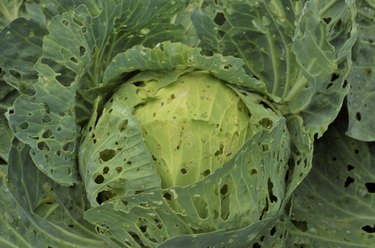
A variety of garden critters earn the name "worm." Some of these--such as earthworms--benefit your soil and your garden, while others can cause serious harm to your plants and fall into the "pest" category. The unwelcome worms, and equally damaging insect larvae commonly called worms, damage plant roots or eat plant leaves. Some worms and their damage are easily visible and easily identifiable, but others require you to investigate a bit more.
Step 1
Determine the location of the pest on the plant. Cabbage maggots--the larvae of flies hatched from eggs laid near the plant's base--develop underground and attack plant roots. Most other wormlike pests tend to attack flowers, fruits and foliage.
Video of the Day
Step 2
Observe the color of the worms found on the foliage of cabbage (Brassica oleracea capitata group) and related vegetables, such as broccoli (Brassica oleracea italica group). The cabbage webworm (Hellula rogatalis) is white with dark stripes lengthwise on its body. The imported cabbageworm (Artogeia rapae) is green and moves slowly, while the cabbage looper (Trichoplusia ni), also green, has thin stripes down its sides and moves like an inchworm.
Step 3
Distinguish wormlike pests found on tomatoes (Solanum lycopersicum), corn (Poaceae) and peppers (Solanaceae). The fall armyworm (Spodoptera frugiperda) has three yellowish stripes down its sides and dark spots on its back in groups of four. These pests destroy the foliage of plants. Corn earworms (Helicoverpa zea) damage corn plants and look similar to the fall armyworm. You can distinguish them by the three or four stripes on their backs and their yellow heads. Cutworms vary in color, with species appearing brown, pink, green and black. When touched, they curl into a C shape. Cutworms sever seedling stems at or slightly above ground level. They afflict many nonwoody plants. You can distinguish a green tomato hornworm (Manduca quinquemaculata) by the black horn protruding from its back. These caterpillars measure up to 4 inches in length and devour the foliage of tomatoes, peppers and eggplant. You can sometimes detect them by the presence of dark-colored droppings on the leaves.
Step 4
Look for any wormlike organisms or caterpillars on your ornamental plants. Caterpillars frequently wreak havoc on ornamentals, especially woody plants. The fall webworm, for example, is a bristly, black-spotted yellow caterpillar that forms webs among the branches of woody plants, feasting on their leaves.
Tip
If you're stumped by trying to identify a troublesome garden pest, you can turn to your local cooperative extension office for help. Affiliated with land-grant universities, these offices often offer help in identifying garden pests and provide advice about how to prevent and treat pest problems. Because of their tiny size, nematode identification requires professional analysis of a soil sample.
Annual garden vegetables, such as corn, peppers and cabbage, grow in all US Department of Agricultural plant hardiness zones during the summer months.
Video of the Day
- University of Missouri Extension: Managing Nematodes in Gardens
- Virginia Cooperative Extension: Cabbage Webworm
- University of Illinois Extension: Cabbageworm
- Virginia Cooperative Extension: Fall Armyworm in Vegetable Crops
- University of Wisconsin Extension: Corn Earworm
- Horticulture: Q&A: Latin for Vegetables
- Burpee: The Newly Revised USDA Plant Hardiness Zone Map